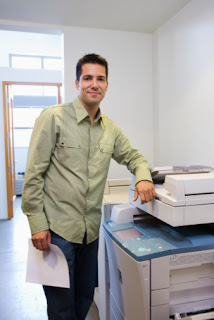 As if individuals and businesses didn't already have their plates full concerning security and safety, they must now add digital copiers to the list of potential security risks which could leak sensitive and personal data. While it’s common knowledge that leaving sensitive information in trash bins or on computers raises the risk of identity theft, many consumers and even IT professionals may not be aware that copy machines themselves also put them at risk. If you didn't know, most modern copiers, or multifunction printers, use hard drives just like the one found in your computer to store every single document copied, scanned, or emailed by the machine. A single machine could have years worth of data and thousands of documents which could give away client records, birth certificates, tax forms, financial records, or even employee social security numbers making these copiers a proverbial pot of gold for criminals.
As if individuals and businesses didn't already have their plates full concerning security and safety, they must now add digital copiers to the list of potential security risks which could leak sensitive and personal data. While it’s common knowledge that leaving sensitive information in trash bins or on computers raises the risk of identity theft, many consumers and even IT professionals may not be aware that copy machines themselves also put them at risk. If you didn't know, most modern copiers, or multifunction printers, use hard drives just like the one found in your computer to store every single document copied, scanned, or emailed by the machine. A single machine could have years worth of data and thousands of documents which could give away client records, birth certificates, tax forms, financial records, or even employee social security numbers making these copiers a proverbial pot of gold for criminals.Even if the copier deletes the image, once it has been printed, the file remains on the hard drive until fully overwritten. Off lease and out of service copiers that are no longer needed will often depart without the previous owner even giving a second thought to the nature of the documents the machine previously handled. Businesses that don’t scrub this data before disposing of the machines are handing over vast amounts of potentially sensitive data to the next owner and possibly a criminal. Copier hard drives should be completely overwritten and reformatted with the original copier software reinstalled. However, the best method to absolutely ensure your data never falls into the wrong hands would be to purchase and install a brand new copier hard drive and then physically destroy the previous hard drive.
A recent investigation conducted by the CBS News proved just how dangerous of a problem this is. CBS purchased four used copiers from a warehouse in New Jersey and quickly went about gleaning all the data from the hard drives. The results were worse than anticipated. Two were once leased to the Buffalo police and the copiers were found to have very sensitive information including reports of domestic violence, a list of wanted sex offenders and even information about suspects from a drug investigation. The third machine contained copies of pay stubs that revealed names, addresses, and social security numbers while the fourth machine came from a New York insurance company with over 300 pages of medical records.
As a result, the Federal Trade Commission is tackling the problem and "now reaching out to copier manufacturers, resellers and retail copy and office supply stores to ensure that they are aware of the privacy risks associated with digital copiers and to determine whether they are warning their customers about the risks." Currently there are no known crimes involving information being stolen from copier machines. But now that the potential security flaw has been brought to the public's attention, there will no doubt be criminals who will try this method of identity theft.
Looking for a Copier Rental to help with your next big project? Call 800-736-8772 today and ask about our Office Equipment Rentals.

